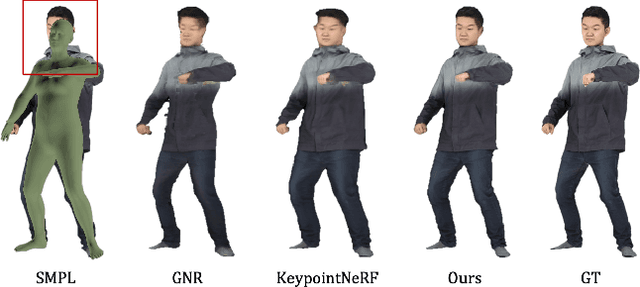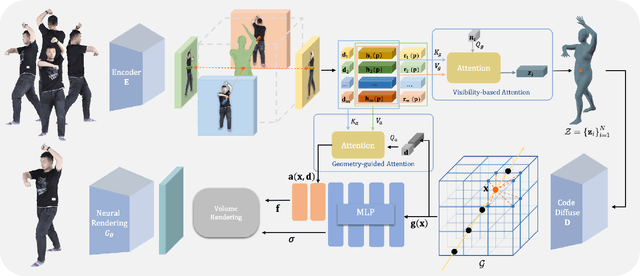Wentao Yi
GM-NeRF: Learning Generalizable Model-based Neural Radiance Fields from Multi-view Images
Mar 24, 2023



Abstract:In this work, we focus on synthesizing high-fidelity novel view images for arbitrary human performers, given a set of sparse multi-view images. It is a challenging task due to the large variation among articulated body poses and heavy self-occlusions. To alleviate this, we introduce an effective generalizable framework Generalizable Model-based Neural Radiance Fields (GM-NeRF) to synthesize free-viewpoint images. Specifically, we propose a geometry-guided attention mechanism to register the appearance code from multi-view 2D images to a geometry proxy which can alleviate the misalignment between inaccurate geometry prior and pixel space. On top of that, we further conduct neural rendering and partial gradient backpropagation for efficient perceptual supervision and improvement of the perceptual quality of synthesis. To evaluate our method, we conduct experiments on synthesized datasets THuman2.0 and Multi-garment, and real-world datasets Genebody and ZJUMocap. The results demonstrate that our approach outperforms state-of-the-art methods in terms of novel view synthesis and geometric reconstruction.
Pixel2ISDF: Implicit Signed Distance Fields based Human Body Model from Multi-view and Multi-pose Images
Dec 06, 2022Abstract:In this report, we focus on reconstructing clothed humans in the canonical space given multiple views and poses of a human as the input. To achieve this, we utilize the geometric prior of the SMPLX model in the canonical space to learn the implicit representation for geometry reconstruction. Based on the observation that the topology between the posed mesh and the mesh in the canonical space are consistent, we propose to learn latent codes on the posed mesh by leveraging multiple input images and then assign the latent codes to the mesh in the canonical space. Specifically, we first leverage normal and geometry networks to extract the feature vector for each vertex on the SMPLX mesh. Normal maps are adopted for better generalization to unseen images compared to 2D images. Then, features for each vertex on the posed mesh from multiple images are integrated by MLPs. The integrated features acting as the latent code are anchored to the SMPLX mesh in the canonical space. Finally, latent code for each 3D point is extracted and utilized to calculate the SDF. Our work for reconstructing the human shape on canonical pose achieves 3rd performance on WCPA MVP-Human Body Challenge.
 Add to Chrome
Add to Chrome Add to Firefox
Add to Firefox Add to Edge
Add to Edge